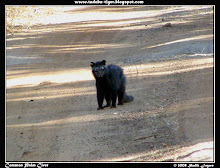(News taken from Times Of India 8 May 2009, 0201 hrs IST written by Vijay Pinjarkar, TNN)NAGPUR: In villages around
Tadoba Andhari Tiger Reserve, tigers are villains. Starved of prey base in forests outside the reserve, they have attacked cattle and also, quite frequently, human beings. Now, with a 1067 sq km area around the reserve being identified as the buffer zone by the state forest department, the villages will get funds under the centrally sponsored scheme (CSS) in future.
The
buffer zone identified as the critical tiger habitat (CTH) comprises 79 villages. It will be in addition to the core area of 625 sq km of TATR. The
TATR buffer area includes 671.37 sq km forested area and 393.83 sq km non-forested area. The move follows amendment to Wildlife (Protection) Act, 1972 in September 2006. The government has been asked to identify the peripheral area critical to the
tiger habitat, designate it as buffer zone and prepare a
tiger conservation plan (TCP) for both
core and buffer zones.
Initially, on the basis of scientific data, preliminary buffer zone proposal of August 14, 2007, included around 133 villages in Chimur, Sindewahi, Mul, Warora, Brahmapuri, Bhadravati and Chandrapur tehsils with a forest area of 69,099 hectares and non-forest area of 46,295 hectares amounting to 1153.94 sq km. However, after discussions held on April 24 the expert committee on buffer zone has finalised a proposal for 1067.21 sq km having 79 villages.
According to principal chief conservator of forests (PCCF) B Majumdar, the buffer was necessary to ensure integrity of
TATR. "It's a
legal requirement. We will ensure that
agricultural,
livelihood, development and other interests of the people living in
tiger sensitive patches in buffer are not affected. The areas will remain as it is. Only status of
protection will be increased."
Nandkishore,
chief conservator of forests (CCF) for Nagpur wildlife circle, said: "We will ensure ecologically compatible land uses so that
wildlife is not harmed. We'll also aim to promote
man-animal co-existence with due recognition to the rights of the people. The approved buffer zone proposal will be soon sent to the
National Tiger Conservation Authority (NTCA). The NTCA will later refer it to the state government for notifying it."
In the buffer zone, highest 66 villages are in Chandrapur forest division, followed by 13 from Brahmapuri division. Although the buffer includes 12,550 hectare area of West Chanda division, not a single village falls in the proposed area. Interestingly, the buffer proposal also includes
compartment number 390, where
coal mines of
Adani Power Limited have been proposed. The buffer also includes some 7-9
compartments proposed for mining near Agarzari near Tadoba. These blocks have been proposed by the
Maharashtra State Mining Corporation (MSMC). "The mining blocks have been included because these are within 10 km of the tiger reserve," officials told TOI.
Kishor Rithe, member of the state committee for buffer area to critical tiger habitats (CTHs), who was part of the meeting held on April 24 to approve the buffer proposal, said: "
Coal has taken toll on water, fresh air, health, agriculture etc. But now
tigers will prove to be a bigger boon for
Chandrapur district than
coal. Buffer area of the
TATR will have a legal sanctity now. It will boost economic and ecological development of Chandrapur. This is the beginning of
environmental democracy and coming months would frame the 'real economic-ecological development'
package for the villages living around
TATR."
Rithe further said people in buffer area will not face displacement nor will they have to fight for funds for their development. Government will have to work with villagers for their economic-ecological sustainable development. This is the real 'win-win' situation for tigers as well as stakeholders.
On March 17, 2008, officials of
wildlife wing, territorial and Forest Development Corporation of Maharashtra (FDCM) had reached a consensus on creating buffer zones around three tiger reserves -
Tadoba, Melghat and Pench - situated in
Vidarbha. As per the amendment to section 38(v)(2) of the
Wildlife Protection Act 1972, establishing a buffer or peripheral area around
tiger reserves is mandatory.
The Wildlife Institute of India (WII) has already suggested that for every 20 breeding tigresses, an area of 800-1,000 sq km be maintained inviolate. This would help maintain an overall population of 70-100 tigers that would be maintainable in the patch around the buffer areas. Nandkishore informed that consultations with the gram sabhas were done and people have been told about the benefits.




 Forest Types
Forest Types































